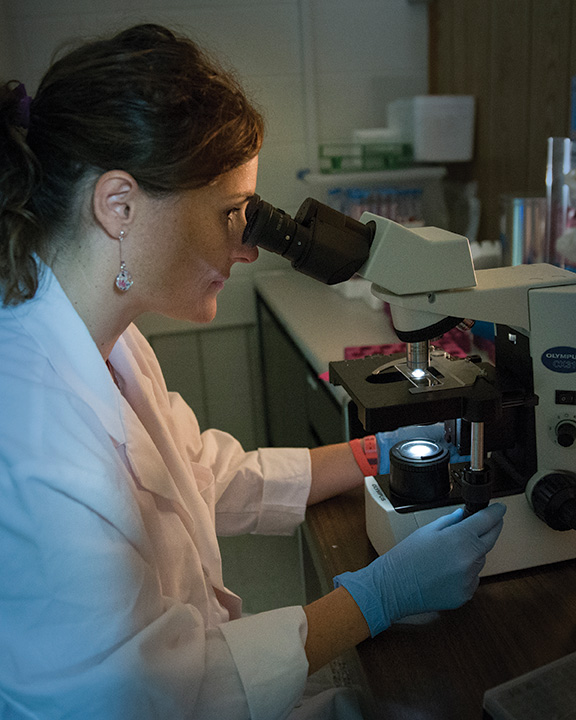Texans help researchers map Lyme disease in Texas
In recent years increasing numbers of Lyme disease cases have been reported in Texas, a state that was once considered free of the disease, and researchers at the Texas A&M College of Veterinary Medicine & Biomedical Sciences (CVM) have turned to the public for help. Dr. Maria D. Esteve-Gassent, an assistant professor in the Department of Veterinary Pathobiology (VTPB) at the CVM, and her lab seek ticks that Texans have found on either themselves or their pets. The researchers then test the ticks for bacteria, including those that cause Lyme disease.

Lyme disease is a zoonotic, tick-borne illness caused by the bacterium Borrelia burgdorferi. Each year, approximately 30,000 cases of Lyme disease are reported, according to the Centers for Disease Control and Prevention (CDC). Dogs, cats, horses, and cattle-in addition to humans-can all develop Lyme disease. Infected tick vectors transmit the bacteria while biting humans and susceptible domestic animal species. Although Lyme disease is effectively treated with antibiotics when diagnosed early, often people are found to have the disease only after numerous tests. Therefore, Esteve-Gassent encourages the public to send her any ticks they find. “We want to tell everyone who finds a tick to send it to us, don’t squish it or flush it,” said Esteve-Gassent. “We will be able to tell you if it is positive for the bacteria-which can help people have an early warning that they might have the disease-and for us it provides invaluable information about where and when people get in contact with these ticks, as well as which species of tick they are.”
Esteve-Gassent and her team use polymerase chain reaction (PCR) methods to find the bacteria’s DNA within each tick, thus giving them molecular evidence of the pathogens’ presence. In addition to Lyme disease, her lab also studies other diseases spread by ticks:
Tick-borne relapsing fever (TBRF) is transmitted to humans through the bite of infected soft ticks, which can be very difficult to find because they don’t attach to skin for more than a few seconds. Therefore, many people who are infected don’t have any known history of a tick bite.
Anaplasmosis is transmitted to humans by tick bites primarily from the blacklegged tick (Ixodes scapularis) in the northeastern and upper midwestern United States and the western blacklegged tick (Ixodes pacificus) along the Pacific coast. Although this disease-which can affect humans and dogs-is rarely seen in Texas, a closely related disease that affects cattle is present in the state.

Ehrlichiosis is transmitted to humans by the lone star tick (Ambylomma americanum), which is found primarily in the southcentral and eastern United States.
One of the biggest goals of the project is to create an accurate map of where in Texas these different species of ticks are found. “When I first started the research, I was staring at a map of Texas, as I wasn’t sure where to even begin,” Esteve-Gassent said. “The trouble is that when you look at where most of the cases of Lyme disease are recorded, you have clusters around the major cities in Texas, but that doesn’t tell us much about where these people were infected. Most of the ticks are probably not going to be in developed urban areas.”
The number of ticks in the environment changes from year to year, which makes such mapping efforts even more difficult. Variation depends strongly on rainfall, and more rain means more ticks. “The ticks are very sensitive to humidity,” said Esteve-Gassent. “The burst of ticks that people notice in years of heavier rainfall is normal.”
To surmount some of these difficulties, the team has developed partnerships with Texas Parks and Wildlife, Texas A&M Veterinary Medical Diagnostic Laboratory (TVMDL), USDA-ARS, the Brazos Valley Animal Shelter, hunters, the CVM parasitology lab, Lyme disease support groups in Houston and Austin, and local veterinarians.
With the help of the public and their partners, the researchers are collecting a number of ticks. Texas Parks and Wildlife and private hunters help to collect ticks from deer, feral swine, and any other wild animals. The TVMDL, local shelters, and veterinarians submit ticks found on pets and other domestic animals. Lyme disease support groups and others in the public help spread the word about submitting ticks people find on themselves.
Although these passive surveillance methods aren’t a perfect sampling, once they know where to look, the researchers can go out into the field and take samples the traditional way.
“We have to depend on the public to help us with this research,” Esteve-Gassent said. “But they’ve been wonderful. The project started off slowly, but now we usually get at least one or two ticks a day.”
If you find a tick on you or your pet anywhere in Texas, please send it to Esteve-Gassent at 4467 TAMU, College Station, Texas, 77843. The ticks should be sealed in a plastic bag with a cotton ball soaked in rubbing alcohol. Please include the location (city or zip code) where the tick was found, the location on the body, and contact information so the researchers can send you the results.


